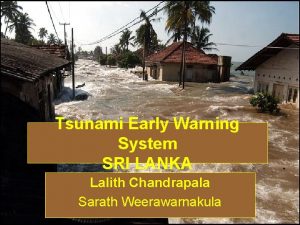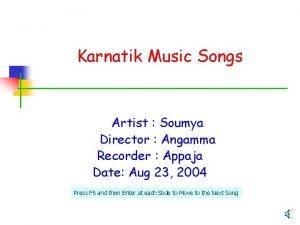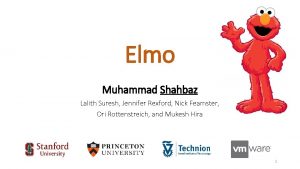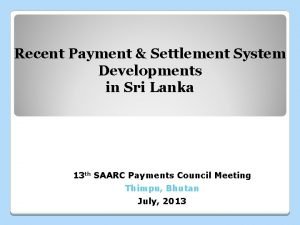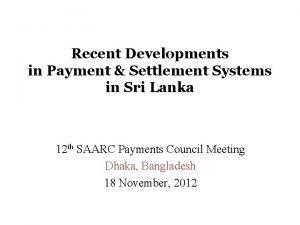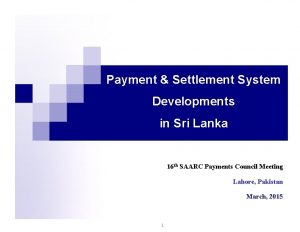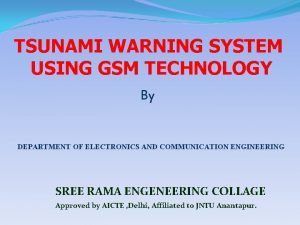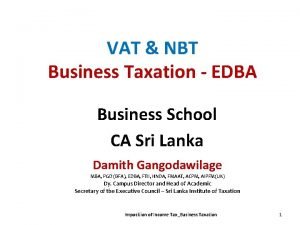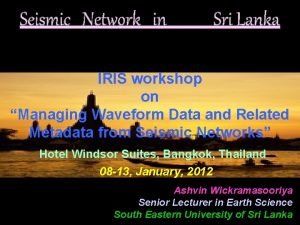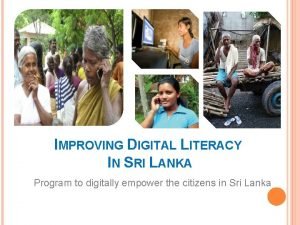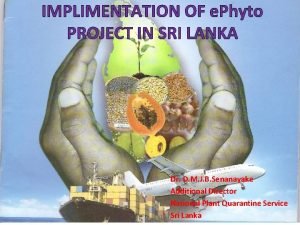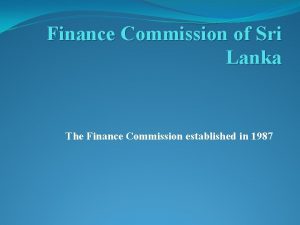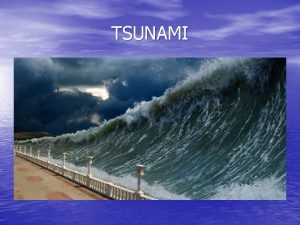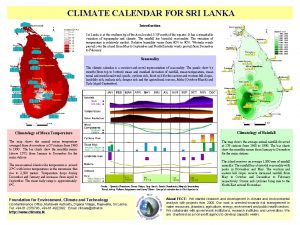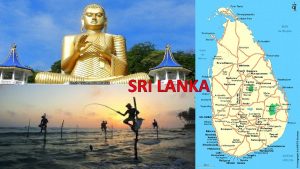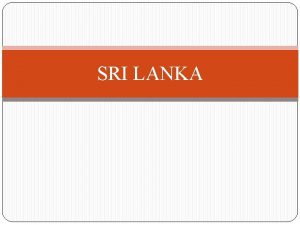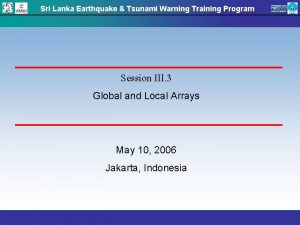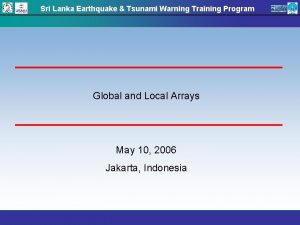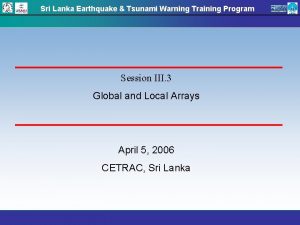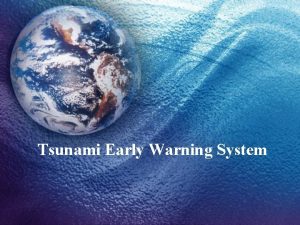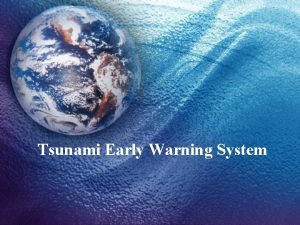Tsunami Early Warning System SRI LANKA Lalith Chandrapala
















- Slides: 16

Tsunami Early Warning System SRI LANKA Lalith Chandrapala Sarath Weerawarnakula

Early Warning System in Sri Lanka • No Early Warning System for Tsunami prior to 26 -12 • Different Government Institutions mandated to monitor and issue Early Warnings in the case of different hazards (e. g. Meteorology for weather related, NARA for Oceanic, GSMB for seismological, NBRO for landslides etc. ) • After 26 -12, Department of Meteorology was

Early Warning System in Sri Lanka • A Technical Committee representing all stakeholders appointed to coordinate the activities of the EW Centre. • Connected with Pacific Tsunami Warning Centre and Japan Meteorological Agency thro’ telephone/fax • Technical Committee will become the ‘TAC on Early Warning of DMC’ once an EWC is established at the Disaster Management Centre (DMC).

Early Warning System in Sri Lanka • Seismic Information is received from – California Integrated Seismic Network (supplied from IOC) – Pallekele GSMB Seismic Station (from the display at GSMB HQ) – Pacific Tsunami Warning Centre - Advisories – Japan Meteorological Administration - Advisories

Early Warning System in Sri Lanka Usually the EWC receives information about seismic events in the following order. Minute Locati Magnit Source of information s after the event Seismic Monitoring Centre @ GSMB 5 -10 minute s California Integrated Seismic Network (CISN) 10 minute s Pacific Tsunami Warning Centre (PTWC)* 15 -20 minute s Japan Advisories * through Meteorological Over 30 on Info. ude Info No No Yes (Prelimin ary) Yes Yes

Early Warning System in Sri Lanka Three Tide Gauges at Colombo Kirinda and Trincomalee (Maintained by NARA) Information on sea level changes available to EWC only through the Internet. Hawaii Sea Level Centre Web site NARA website

Early Warning System in Sri Lanka • Warnings/Advisories on Tsunami are issued based on seismic data. • However, Sea Level Information from Indonesian gauges, particularly the gauge at Sibolga, is used for guidance in addition to the guidance provided by PTWC and JMA. • Advisory is issued within 30 minutes of the Earthquake

How Warnings are Issued …… Magnitude of oceanic EQ 6. 5 to 6. 9 7. 0 to 7. 4 7. 5 to 7. 7 Over 7. 8 EWC keeps close watch on Tide gauge data available in the internet (Hawaii SLC). No official bulletins are issued Earthquake Information Bulletin is issued informing about the occurrence of the Earthquake Information Bulletin is issued indicating the location, magnitude of the Earthquake, and requesting the public to be ready for evacuation at short notice. Tsunami Advisory Bulletin is issued requesting public in vulnerable regions

Once a Bulletin is issued …… Dissemination to relevant authorities/institutions and communities through 1. Media (Radio and Television) [most effective and efficient!] 2. through Regional Police Stations 3. Military Communication Systems

15 minutes Earthquake Seismic Info • GSMB Info • CISN • PTWC • JMA If people receive the warning in 45 minutes, then they have over one hour to respond Early Warning Centre Sea Level Info Media – direct to communities Police (Police HQ to Regional Police Stations and then to communities) Military communication system to communities Issue of Advisory in 30 mnts.

Educating Public is very important ! Over 93. 5 % of the vulnerable coastal population in Sri Lanka have not even heard about ‘tsunami’ prior to last episode. (ADPC, 2005) However, the present situation is different! • A large number of seminars/workshops/meetings have been

Educating Public is very important ! Over 93. 5 % of the vulnerable coastal population in Sri Lanka have not even heard about ‘tsunami’ prior to last episode. (ADPC, 2005) However, the present situation is different! A good example On 28 th March 2005 Magnitude 8. 7 Within 55 minutes of the issuance of the Advisory Bulletin, all people evacuated.

Evacuation on 28 th March 2005 was not one hundred percent ideal BUT evacuation was completed within 55 minutes Kalmunai, Eastern Sri Lanka on 28 th March 2005

Timeline – 28 th March 2006 28/2210 hrs SLST Earthquake in Indonesia 28/2220 hrs SLST wave pattern PALK station pickup unusual 28/2230 hrs SLST at EWC PTWC Bulletin Number 1 received 28/2255 hrs SLST Evacuation begins Tsunami Advisory issued – 28/2350 hrs SLST Evacuation completed, Tide Watchers deployed by SLN- 45 mints Time to issue advisory 29/0300 hrs SLST All Clear by EWC Time between issue of advisory andissued evacuation completion - 1 hr 40 mnts Time between start and end of evacuation – 55 mnts

Posters and Leaflets have been distributed …….

Thank You
 Tsunami early warning system sri lanka
Tsunami early warning system sri lanka Sri rama sri rama sri manoharama
Sri rama sri rama sri manoharama Lalith suresh
Lalith suresh Payment and settlement system in sri lanka
Payment and settlement system in sri lanka Payment and settlement system in sri lanka
Payment and settlement system in sri lanka Payment and settlement system in sri lanka
Payment and settlement system in sri lanka Tsunami warning system
Tsunami warning system Nbt tax
Nbt tax Tiep scheme
Tiep scheme Food and beverage industry in sri lanka
Food and beverage industry in sri lanka Where is the seismometer in sri lanka
Where is the seismometer in sri lanka Digital literacy in sri lanka
Digital literacy in sri lanka Phytosanitary certificate sample
Phytosanitary certificate sample Finance commission of sri lanka
Finance commission of sri lanka Labai lk
Labai lk Uwl mitigation
Uwl mitigation Corporate governance in sri lanka
Corporate governance in sri lanka
